At dusk on December 6th 2014, NM found a striking-looking dark grey, brown, black and white immature gull in among a flock of several hundred large gulls at the mouth of the Namdaecheon Stream in Gangneung City, on the East Sea coast of Gangwon Province. Based on previous limited experience and on recent review of a small number of images for an identification article on Slaty-backed Gull Larus schistisagus and North American west coast hybrids, NM’s immediate impression was that this looked like a First-winter (First Cycle) Western Gull Larus occidentalis. A series of about 30 digi-scoped images were hurriedly taken with a handheld camera through a (superb) tripod-mounted Swarovski scope as the bird preened 100m or so away, before it crossed the river-mouth to another low island as night fell, flying up and resettling several times before it became too dark to see.
During the observation (which spanned about 15 minutes, with probably 2-3 minutes of the bird in proper view), NM looked specifically for characters that could first rule out an aberrant Slaty-backed Gull (initially considered to be the default ID) and then for characters that would indicate a hybrid origin. He was joined first by Subhojit Chakladar, who after looking briefly at the bird kindly helped NM record notes into his phone, and then by Jason Loghry, who could still pick the bird out in near-darkness due to its distinctive appearance.
The bird (for clarity’s sake, nicknamed from hereon as the “Gangneung Gull”) was searched for again in the morning of the 7th, but not seen. Indeed, few large gulls were present at this time, as the site seems most-used by large gulls in the evening for bathing and preening.
Intrigued by the Gangneung Gull’s appearance (and keen to learn more about Western Gull and “Olympic Gull” identification), a request for information was made on December 8th to several expert gullers on the west coast of North America, supported by an online account and several of the unaltered digiscoped images, selected to show a range of features. All references from hereon to “Gull 1”, “Gull 2” etc. relate directly to these images and numbering used in that initial online account, found directly below this note.
Multiple insightful and helpful responses were received in response, especially from Tristan McKee and Peter Pyle (the two lead authors of the identification article on Slaty-backed Gull mentioned above). Both queried certain features and both shared some of their images of Western Gull, all taken in California in dull weather during on December 10th and 11th 2014, a few of which are presented here.
To summarise our online discussion:
- Although the identification of many large gulls is greatly complicated by factors that include massive individual variation and hybridization in some taxa, the Gangneung Gull indeed looks closest to a Western Gull, for many of the same reasons presented in the original account. The initial shocked response to the images by TM, before reading any text, was indeed remarkably similar to the even-more shocked response of NM when first seeing the bird!
- The bird is presumed to be a First-winter / First Cycle. The possibility of an older bird with greatly delayed moult was also discussed and thought unlikely, based on field impressions and e.g. a combination of a lack of dark grey in the wing coverts and bare parts coloration etc.
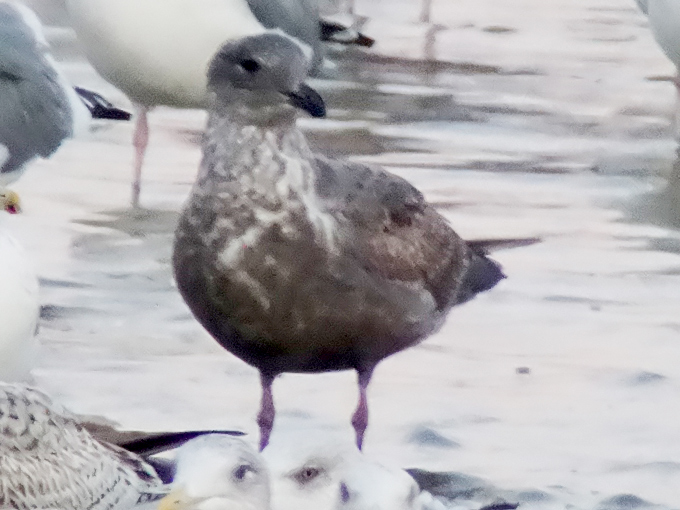
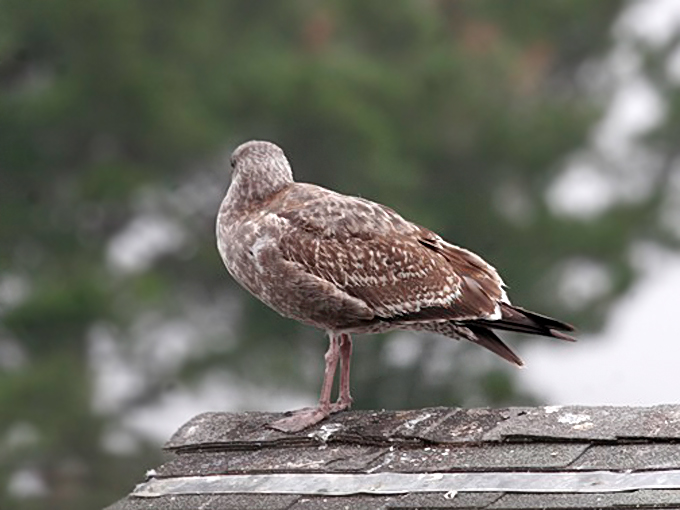
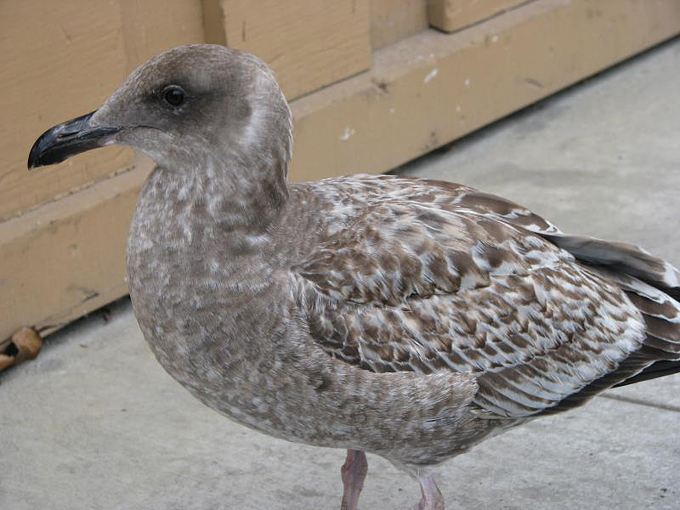
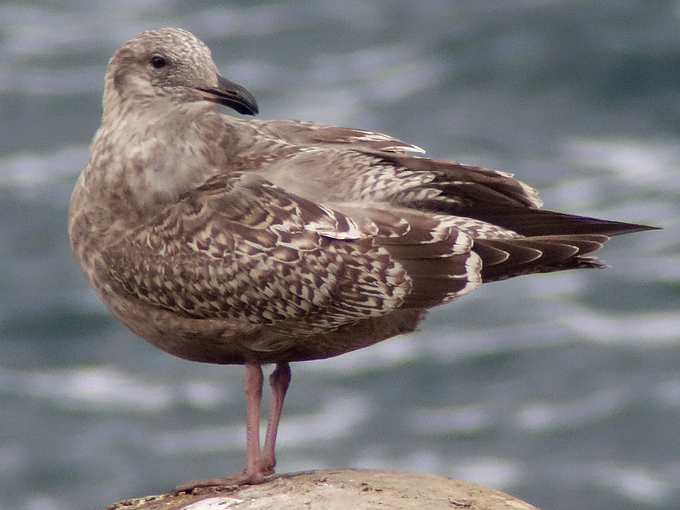
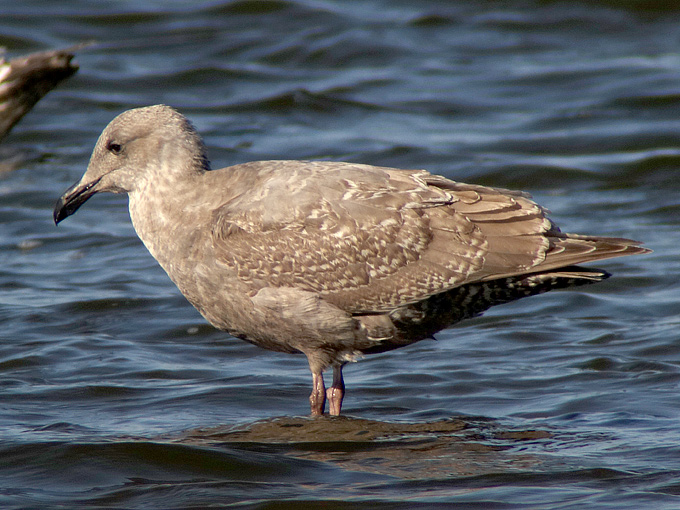
- Western Gull hybridizes frequently with Glaucous-winged Gull where their breeding ranges meet (with offspring referred to as “Olympic Gull”). The possibility of hybrid influence always needs to be considered deeply when looking at an out-of-range Western-type gull.
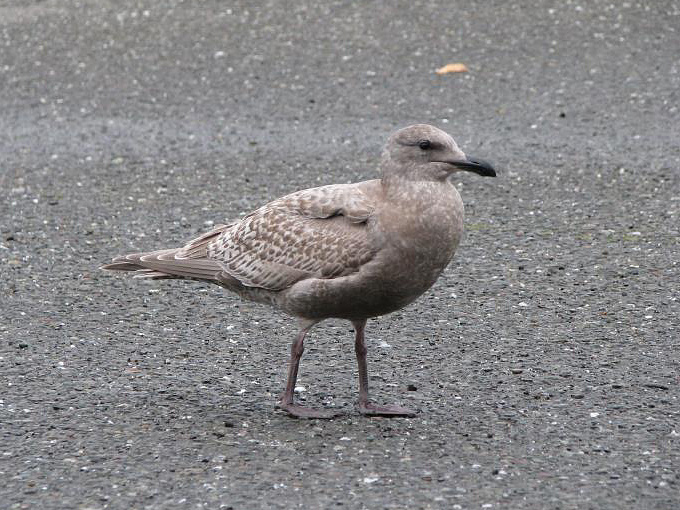
- Based on the bill and structure, if a Western, it is most likely a female.
- Although too much should not be read into this, First-winter female seems the most likely sex and age of Western Gull to travel furthest from the breeding area (see: Spear’s January 1988 paper “Gull Dispersal” in The Auk 105: 128-141.
- The initial online description by NM of “a strongly contrasting whitish rump and uppertail coverts (both weakly patterned, and certainly not spangled or densely barred with brown) with an apparently all-dark, blackish tail and paler area on the vent” seemed to NM to overstate the expected contrast shown by First-winter Western Gull (further helping prompt consideration of it being an older age or of hybrid origin). Notes taken at the time state more plainly that the tail looked blackish or blackish-brown and there was “a lot of obvious contrast with an obviously paler rump and darker tail”, and that although looked for specifically, “I did not see any pale on the bases of the outer rectrices, possibly there but certainly not extensive if there”. Perhaps unsurprisingly to those with much more experience of the species than NM, a similar impression of a white base to a rump that lacks dense barring and spangling (as expected in e.g. First Cycle Glaucous-winged Gull Larus glaucescens) and that contrasts with a rather darker tail than expected in e.g. First Cycle Slaty-backed Gull is in fact often shown by First Cycle Western Gull.

- The combination of features seen at the time, most of which are visible in the images, are not shown by potential confusion species at a similar age (i.e. Slaty-backed Gull, Vega Gull Larus vegae, American Herring Gull Larus smithsonianus and Glaucous-winged Gull). This combination of features also seems quite improbable in hybrids between them, apart from perhaps Western x Glaucous-winged Gull (see below). Key features, listed in more detail in the original note below, include decent primary projection (noted during the observation as having a “slightly more attenuated rear end” than Slaty-backed Gull, with “maybe (three or) four primary tips beyond the tail”); a strong gonydeal angle on the bill; dark grey tones in much of the plumage; blackish primaries with only limited pale tips; a lack of pale blaze across the inner primaries of the spread upperwing (see Image 8 below); a strongly contrasting all-dark looking blackish tail with a weakly-patterned white-based rump; and strongly dark underwing coverts.
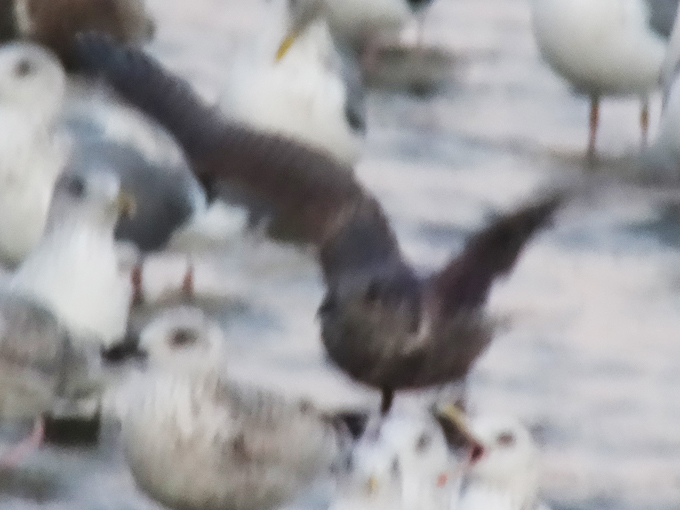
- Three major problems with the ID as a pure Western Gull were identified: (1) the pattern on the underside of the primaries; (2) the greyness of the plumage; and (3) the “saddle” which seems to lack obvious paler fringes. Although perhaps possible in pure Western Gull (?), it also seems possible that these features, if not photographic artefacts, might (also) be shown by offspring of a pair of Western Gull, in which one of the parents had some hybrid influence in its ancestry (e.g., if it was 1/8th Glaucous-winged Gull: PP). This possibility will be investigated further by additional review of images and especially perhaps by an examination of museum specimens by PP.
- In greater detail, the underside of the primaries, especially in the blurred flight shot (“Gull 9”), strongly suggest Glaucous-winged Gull influence, as the flight feathers look strikingly pale, contrasting strongly with the underwing coverts and apparently lacking the dusky wash on the outer primaries shown by most Western Gull. However, there now appear to be multiple problems with this logical interpretation.
- First, some Western Gulls do show (similarly) pale undersides to the primaries, though many do not.
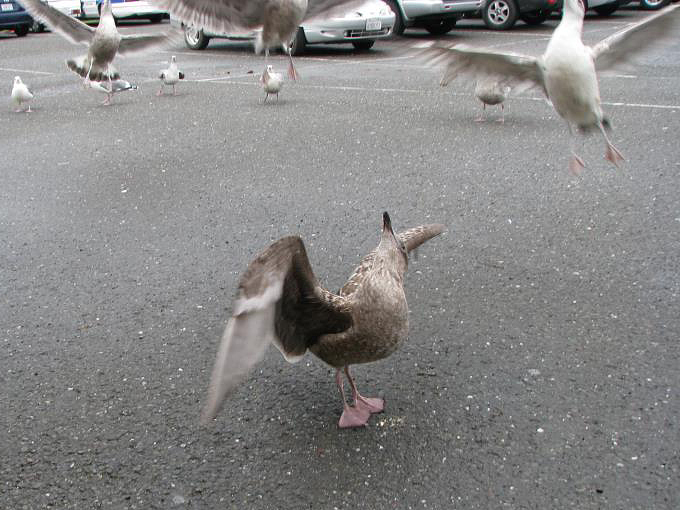
- More importantly, an additional image of the bird showing the underwing before the bird took off (“Gull 8”, omitted from the original post but included here) shows much darker undersides to the outer primaries than suggested in “Gull 9”. “Gull 8” also shows some faint points of opacity in one or more of the primaries (suggesting that this image is good enough to detect contrast and some real detail). Importantly, it matches well with the impression suggested in “Gull 6”.
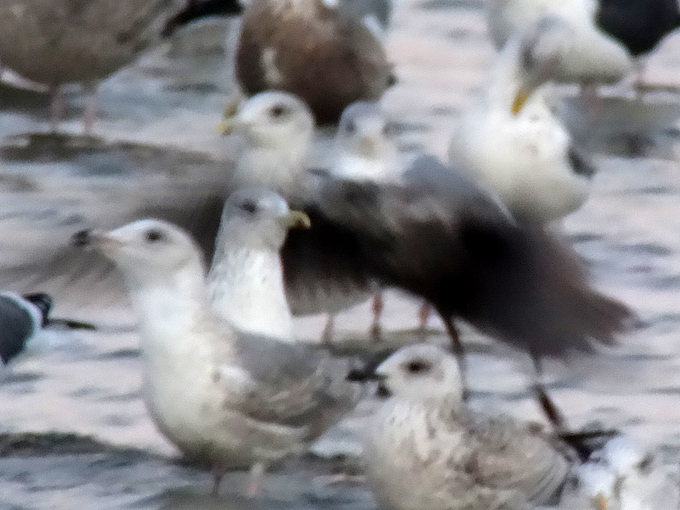
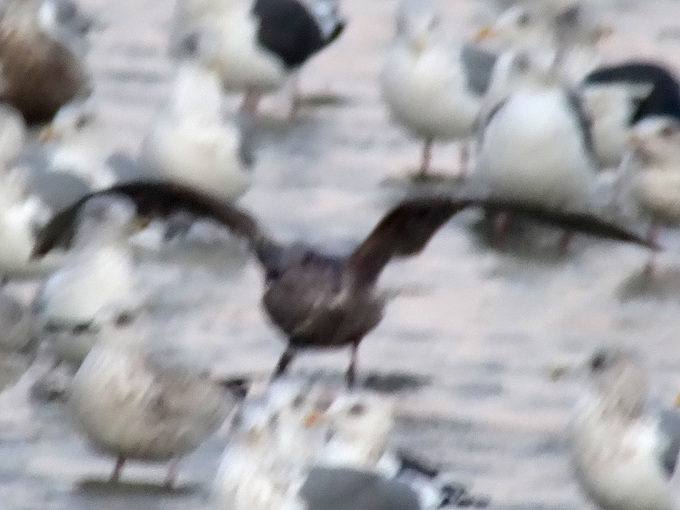
- Although “Gull 9” is most probably the Gangneung Gull (as suggested by the dark grey look to the head etc.), it must also be noted that this digiscoped image was taken of a flying bird at dusk with a handheld camera. It is therefore possible that the wrong bird was captured in the image, as many gulls were in flight and digiscoping in this way requires a lot of luck to find the right bird. The image was also taken in failing light at 1/60th of a second as the bird was moving – conditions in which details sadly really cannot be trusted (per Andreas Kim).
- In both Slaty-backed Gull and Glaucous-winged Gull, the underwings show strong contrast between the mid-dark brown underwing coverts and the silvery-white undersides of the outer primaries, either plain (Glaucous-winged Gull) or lined with dusky tips (Slaty-backed Gull) (see: http://www.birdskorea.org/Birds/Identification/ID_Notes/BK-ID-Slaty-backed-Gull.shtml). The initial online description, based both on recorded notes and review of the images, stated that “On these brief views, the underwing therefore appeared much darker and less contrasting than expected in Slaty-backed or Glaucous-winged Gull”. This seems to be somewhat contradicted by the pattern suggested in “Gull 9”. However, notes recorded during the observation period expand on this: in flight “the underside of the wing looked very dark. There seemed to be a little bit of paler on the underside of the primaries. I certainly did not have good views but I did not see the dusky tips you would expect to see in a Slaty-backed Gull.
It is important to remember the context of these notes. Throughout the observation, NM suspected that he might be looking at an aberrant Slaty-backed Gull or a hybrid, as Western Gull seemed so improbable. The field impression (discussed with SC while watching the bird, but not recorded) was that the underwing looked pretty similar to that of a Slaty-backed Gull, even though it looked much darker on the underwing coverts and showed less contrast on the underside of the primaries than expected.
Based on the images, which show darker undersides to the outer primaries than shown by Slaty-backed Gull, and on the notes recorded at the time, the most plausible explanation is that the underside of the primaries darkened more gradually than in Slaty-backed Gull, with paler inner primaries and diffusely darker undersides to the outer primaries, so that they lacked the expected well-defined contrast: i.e. they were in fact a much better match for a typical Western Gull than for either Slaty-backed Gull or Glaucous-winged Gull.
- The greyness of the plumage, especially of the saddle remains a more persistent issue. As noted by both TM and PP, and is clearly visible in images, the vast majority of First Cycle Western Gulls seen in California in November and December look brown, and lack such extensive grey tones on the head or saddle as the “Gangneung Gull”. Especially troublesome seems to be the lack of obvious pale tips on the saddle, raising the question of when formative grey feathers lacking pale tips actually come through on Western Gull. This important issue remains unresolved for now. However, the following considerations were raised by NM:
- The gull was seen at dusk, and the camera was already struggling to capture details.
- The gull was seen largely from the front, so that grey areas were emphasized; side views (as in “Gull 12”) suggest a rather browner looking bird.
- If the images are sharpened and contrast increased, they confirm that there were pale fringes to many of the darker and grey-centred feathers on the upperparts .
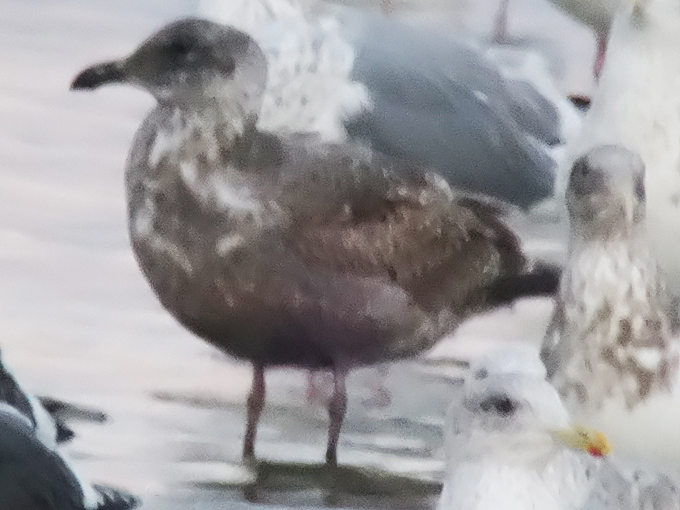
The impression in the field therefore recalled First-winter Glaucous-winged Gull, though “several degrees” darker, with the upperparts lacking any suggestion of clean adult-type grey as shown by e.g. Second Calendar-year Taimyr Gull Larus heuglini taimyrensi or Second-winter Slaty-backed Gull.
This impression seems close to some images of Western Gull taken in February in California. If this is a Western Gull, could the conditions encountered during an especially long dispersal have resulted in earlier moult and / or wear, reducing white and brown tips, helping to create this very dark grey look?
For now, it is clear both that this bird most resembles Western Gull and that Western Gull is a species of the west coast of North America that has not previously been claimed in Korea, or perhaps anywhere in the Palearctic. Although NM has once or twice before seen dark hybrid-types in Korea that seemed to show some Western Gull features (most notably a First-winter in Goseong, Gangwon, in January 2009, seen together with “Team Bavaria”), this is a much more distinctive and rather better-documented individual.
Western Gull might seem to be an unlikely vagrant to Korea. It has a fairly limited breeding range (western North America) and even though it can be locally numerous, its global population is only ~115,000, a third of which are from the more northerly and perhaps more migratory nominate subspecies (http://wpe.wetlands.org/search?form[species]=Western+Gull). It is, most importantly, not generally considered to be a long-range migrant. However, many individuals do move substantial distances north in autumn from breeding areas. It thus occurs north to Alaska (and at least some pure Western and rather more hybrid Western x Glaucous-winged Gull reach SE Alaska with some regularity, according to Heinl’s 1997 paper in Western Birds 28: 19-27, entitled “New Information on Gulls in Southeastern Alaska”). Moreover long-range vagrancy is also proven. It has reached Hawaii at least once (see the 2009 account by R. L. Pyle and P. Pyle. in The Birds of the Hawaiian Islands: Occurrence, History, Distribution, and Status, at: http://hbs.bishopmuseum.org/birds/rlp-monograph/), and Western Gull has also reached New York, on the east coast of the USA (Peter Pyle in lit. 2014).
For now, it seems that all birders interested in gull identification (and in rare species in the national context) should please feel warmly encouraged to search for and help document this bird, especially if they are in or near to Gangneung. After all, gulling helps improve understanding of the various gull taxa and of identification in general; and this Gangneung Gull still has the potential to be both a first for Korea, and also perhaps for Asia!
Acknowledgements
Sincerest and warmest thanks to Tristan McKee and Peter Pyle for investing so much energy and time in a really educational discussion, and for sharing their images; to Steve Hampton and Ken Burton for commenting on the original post; and as always, to Andreas Kim for preparing images and layout.
Your expert opinion is kindly being sought on a large First Cycle / First-winter gull seen and digiscoped very poorly in the evening at Gangneung, Gangwon Province, Republic of Korea on December 6th 2014. It would be wonderfully helpful to have your thoughts on the identity of this bird (shown below on this closed URL) and whether the bird’s identity can be confirmed one way or another, pure or hybrid, based on the images and the description.
The bird was found by NM at 16:55 and seen on and off for 4-5 minutes at dusk in among a flock of several hundred Slaty-backed and Vega Gulls and a few Common Gulls at a pre-roost by the beach (apparently used by gulls that spend most of the day foraging 2-3km+ offshore). The bird was watched and digiscoped through a tripod-mounted Swarovski scope, as it preened about 100m distant from me, before it took flight, crossing 200-300m to land on a small island; then circling then landing again when it was seen distantly 15 minutes later in increasingly worsening light through NM’s scope by two other observers (Subhojit Chakladar and Jason Loghry).
Conditions were clear, with a moderate wind and temperatures close to freezing, but rapidly-failing light.
The sequence of digiscoped images (all by NM) have been cropped and resized a little but otherwise NOT altered. Therefore all plumage tones and details can be compared directly with other gulls that were adjacent to it.
Click on a thumb: every image is opened enlarged in a new browser window.
Description
Note: Notes were dictated onto a phone during the observation period. All salient points that were noted below are included, along with a few details most apparent from a subsequent review of the series of images.
- Impression: The bird immediately stood out to NM as it looked exceptionally dark, with extensive dark grey (intermediate in tone between adult Vega and adult Slaty-backed Gull) on the mantle and also on the breast sides; contrasting with a plain-looking brown wing; and white coming through in splotches and wide streaks on the neck sides (images 4,11,12).
- Structure: It was similar in size to the adjacent Vega and Slaty-backeds (certainly not obviously larger or smaller), and obviously bigger than Common Gull (image 11). It looked big-headed (recalling Glaucous-winged Gull) but perhaps not as deep-chested or quite as pot-bellied as most of the Slaty-backeds (image 4). It was perhaps a little flatter-backed and deeper-bellied than most of the Vega(image 11). The bill was moderately long and showed a strong gonydeal angle and some droop (image 4). The legs were thin-looking when compared with Slaty-backed. The primary projection looked a little longer than Slaty-backed. It had a strong tertial step.
- Bare Parts: The bill was all dark; the eyes were dark; and the leg colour was greyish-pink or off-pink with darker scutes , appearing darker than other gulls in direct comparison and obviously different from all “typical” Slaty-backed of a similar age (images 3,4,5,12).
- Contrast, at Rest: The strongest plumage contrast was the white on the neck-sides and upper breast contrasting with the dark of the upperparts and belly (images 3, 5).
- Contrast, in Flight: a) Views and the images suggest the underwing was mostly dark mud-brown, with an extensive solid-looking block of dark across the underwing coverts and additional dark “lines”, with paler flight feathers (images 6,9). On these brief views, the underwing therefore appeared much darker and less contrasting than expected in Slaty-backed or Glaucous-winged Gull. B) The upperwing (seen poorly) lacked any obvious (any?) pale blaze on the inner primaries, but perhaps had a pale trail (suggested by image 7). C) the bird had a paler half-collar; and D) most especially the bird had a strongly contrasting whitish rump and uppertail coverts (both weakly patterned, and certainly not spangled or densely barred with brown) with an apparently all-dark, blackish tail and paler area on the vent. The rump and tail created an eye-catching contrast when the bird was seen at about 150m distance through the scope, for only a few seconds however, showing much greater contrast than shown by any similarly-aged Slaty-backed Gull or Glaucous-winged Gull knowingly seen to date by NM. Unfortunately, there is no image showing this feature.
- Plumage Details: Head. At rest, the head showed a full, dark greyish, slightly oily-looking hood (much more extensively dark than in any similarly aged Slaty-backed or Glaucous-winged), with some paling to the rear of and above the eye especially (images 2,4,5).
- Plumage Details: Saddle. Much of the “saddle” on more or less head-on views and less clear side views appeared dark grey, with some (small?) upper scapulars (?) showing spotty or streaky black centres and narrow white edges. The lower scapulars had larger dark centres with broader paler tips (images 1,2,4,5,11).
- Plumage Details: Closed wing. The wing coverts were dark brown, with some paler spangling on e.g. the median coverts. The greater coverts showed a strong panel of dark brown, all spangled paler distally, though with this spangling much more extensive distally on the inner than the outer greater coverts (images 1,2,4). The primaries were blackish, with paler tips (2, 11). The pale v’s (?) on the tip were confined to the tip and did not extend down the feather edges as is typical in Slaty-backed or Glaucous-winged (image 2,12).
- Plumage Details: Tail. At rest, the tail appeared black (image 3); in flight the upperside of the tail appeared all dark with no obvious pale at the base of any rectrices (no image). If present, any such pale had to be very limited as it was specifically looked for and not seen.
- Plumage Details: Underparts. On the underparts, white was emerging on the chin, behind the mask and on the breast. Most of the breast sides were infused with dark grey that merged into a plainer dark brown or dark-grey brown belly (images 2,4,5). The vent was white with some random dark marks or weak bars (?) (images 2,4,11).
In closing, just to add that during the past 25 years of gulling in East Asia, NM has never knowingly seen a similar tone of dark grey on the underparts of a Slaty-backed Gull or such extensive dark grey in the upperparts of any Slaty-backed Gull either in December or in its first cycle. NM has never seen such dark grey tones in any Glaucous-winged Gull in Asia or in any of the brief visits to North America. Neither the structure nor the plumage fit any regularly-occurring Korean gull.
The general look of the bird and many of the details therefore immediately reminded NM strongly of Western Gull, seen on three different visits to North America (though never in December).
How appropriate was such an impression? If others think that this bird has Western genes, can hybrid influence be reasonably ruled out? And in order to understand how much encouragement should be given to others to look for this gull or to make any effort with any gull that might look like this (!), how unlikely is Western Gull as a vagrant to Asia? How rare is it north to Alaska or out of range?
Thanks again for any input and advice you can share!
The following comments have been received (on December 8th and 9th) in response to the URL sent to several expert gullers on the west coast of the USA.
Tristan McKee:
“Good points” for Western Gull, “almost everything you mentioned. I can't imagine what else this bird could be …Not as good: the bill looks a bit thin at the base, but certainly not outside the range of Western variation...the streaky look on the breast is not a typical Western thing, but I think that has more to do with the arrangement of feathers than actual feather pattern in this case. In some shots I am seeing some cross-barring on the breast too, which IS very characteristic of Western / Glaucous-winged.
Due to its restricted range and habitat, Western is extremely unlikely to hybridize with anything other than Glaucous-winged. In California, we say it has hybrid influence if the upperside of the primaries or tail are anything paler than very dark brown, or sometimes if the bill looks longer.
This bird would certainly be called a pure Western in California, with only that extremely blurred shot showing the undersides of the primaries suggesting that they may be on the pale side (can't really tell though)… the only thing that sounds odd to me is the whiteness of the rump--I would expect considerable brown barring on a first-cycle bird. But the rump does stand out as having a whitish background, which can blur out fine bars in bright light.”
“Steve Hampton responded that it felt like a first-cycle Western but better photos would be desirable (no further details). Ken Burton said he thought it may have some Glaucous-winged influence (but mostly Western).”
Peter Pyle:
“Well, I wouldn't say that it is not a Western Gull, though a few things might not lead up to it being a classic first-cycle individual.
First, it is very dark, even for a Western. Where I live in Central California the first-cycle birds are paler than this. However, we do get darker individuals like this from the southern California and northern Baja California breeding populations (subspecies weymani). These would seem less likely to turn up in Korea than the nominate northern population, but one never knows.
It looks like the newer formative feathers on the back are entirely dark, without pale fringing. Most Westerns have these feathers with more-obvious pale fringing, but perhaps some can have feathers that come in this dark.
The white streaking on the head and breast is normal, just caused by wet / dishevelled feathers. I think it stands out more on these dark birds simply because of greater contrast.
The bill seems on the thin side for Western, though is probably matched by some females. Your description of the bird's size seems better for female than for male, if a Western.
My greatest concern for Western is the apparent pale under-primaries visible on the shot with half of the bird in flight. Normally the outer primaries on Western are darker than this, among the darkest juvenile primaries one encounters among gulls. They typically grade from dark gray in the inner panel to blackish in the outer primaries, and usually also show even darker/black tips to the outer primaries, which should be apparent in a shot like this. This wing would seem to be more uniformly paler like in some Glaucous-winged x Western hybrids, but I've never seen a bird this dark that I presumed had any Glaucous-winged genes in it…
The closest contending species might be American Herring Gull, some of which have very dark plumage in their first year (these are more common in eastern than in western North America). The under-primary pattern might be a better fit for one of these dark Herrings, but I would certainly not expect the formative feathers to be this dark and to lack pale fringing.”













